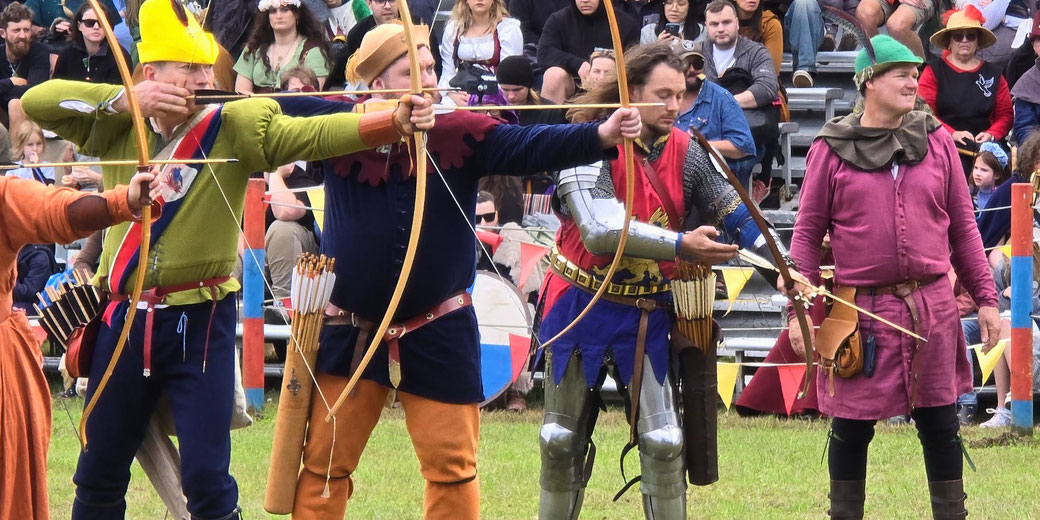Medieval longbow: a weapon of war and skill

In the hands of a skilled archer, the medieval longbow was a deadly weapon, capable of piercing armor and striking enemies from great distances.
For centuries, the longbow was a defining feature of medieval warfare, inspiring legends of heroic archers and shaping the outcome of some of history's most significant battles.
From the hills of Wales to the fields of France, the longbow transformed battlefield tactics, and its impact on the course of history cannot be overstated.
What was a 'longbow'?
The longbow can be traced back to at least the 12th century. It is believed that the Welsh were the first to develop this powerful type of longbow, which they used to great effect in their battles against the English.
However, the medieval weapon has its origins in ancient history as tall bows, roughly the height of a person, have existed since at least the Neolithic period.
After Edward I's conquest of Wales in the 13th century, the English began to adopt the Welsh longbow and it became a staple of the English army.
In 1285, the Statute of Winchester required able-bodied English men to keep arms and train regularly, helping to institutionalise longbow training across England.
The longbow was typically made from a single piece of yew wood. Its length varied, but it was usually between five and six feet long, with a draw weight of between 80 and 160 pounds.
The bow was characterized by its tall, narrow shape, which was usually straight when unstrung.
Once strung, the flexibility of the yew wood and the powerful draw weight was crucial to its ability to propel arrows over great distances.
Why was it so effective?
One of the longbow's most significant advantages was its range.
A skilled archer could shoot an arrow up to 250 yards (228 meters) with a longbow, making it an ideal weapon for attacking enemy troops from a distance. Although typically its effective combat range was closer to 150 yards (137 meters).
Up to 10 arrows per minute could be shot by a well-trained archer, giving armies a powerful advantage in delivering sustained volleys during battle.
The longbow's power also made it capable of piercing chainmail and some plate armor at short range, making it a formidable weapon against armored knights.
The longbow's use was most famously demonstrated during the Hundred Years' War between England and France.
The English army, composed heavily of longbowmen but supported by other infantry units, won several crucial battles against the French, including the Battle of Crecy in 1346 and the Battle of Agincourt in 1415.
At Agincourt, the English army, led by King Henry V, faced an overwhelming force of French knights.
Despite being vastly outnumbered, the English longbowmen were able to inflict heavy casualties on the French, thanks in part to the longbow's power and range.
Training
The longbow's success on the battlefield was not without its challenges, however.
Training for English longbowmen typically began in childhood. Boys were encouraged, and later legally required, to practice archery regularly, often from the age of seven.
Under Edward III in 1363 and later Henry VIII, laws were passed that required all English males to practise archery on Sundays, reinforcing its central role in military readiness.
Training to become a skilled longbowman was a difficult and time-consuming process, requiring years of practice and dedication.
Mastering the longbow required exceptional strength and endurance. The draw weight of the longbows meant that they had to be capable of pulling back up to 160 pounds (72 kg) of weight.
However, the longbow's power came at a cost; it was physically demanding to use, and prolonged use could lead to serious injury.
Archaeological studies of skeletons have found the longbowmen regularly developed enlarged left arms and bone spurs, and often had slightly twisted spines.
Decline
Despite these challenges, the longbow played a central role in English warfare during the 14th and 15th centuries, in particular.
Its use declined in the centuries that followed, however, as advances in gunpowder technology made firearms a more effective and efficient choice on the battlefield.
Nevertheless, the longbow's legacy endures, and it is remembered as a significant weapon in the history of medieval warfare.
What do you need help with?
Download ready-to-use digital learning resources
Copyright © History Skills 2014-2025.
Contact via email
With the exception of links to external sites, some historical sources and extracts from specific publications, all content on this website is copyrighted by History Skills. This content may not be copied, republished or redistributed without written permission from the website creator. Please use the Contact page to obtain relevant permission.





